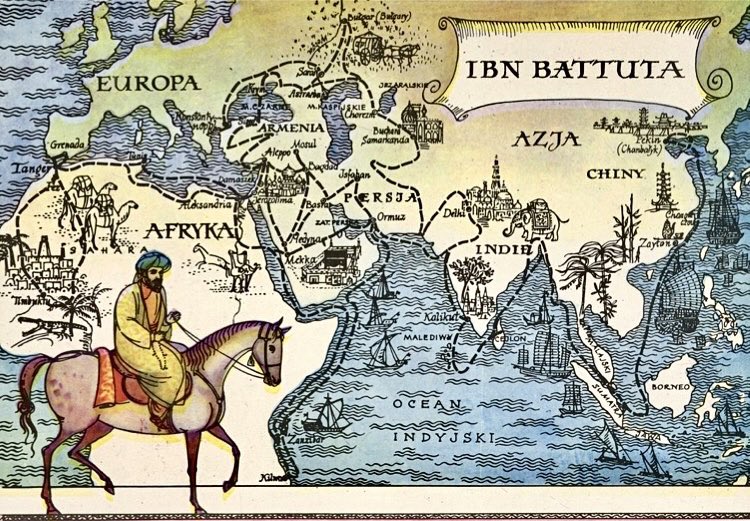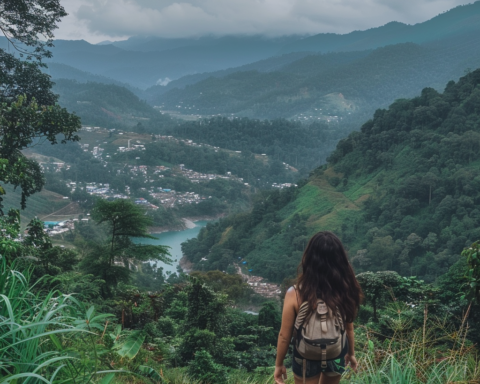In the annals of history, there are only a few individuals whose audacious expeditions have left an indelible mark on the world. Among these legendary explorers, Ibn Battuta, the intrepid Moroccan traveler, stands tall as one of the most remarkable and daring adventurers of the 14th century. Born in Tangier in 1304, Ibn Battuta embarked on an epic odyssey that would span nearly three decades and cover over 75,000 miles, an unparalleled distance for his time. His journey, chronicled in his famous travelogue “Rihla,” serves as a gateway to understanding the medieval world’s geographical expanse, cultural diversity, and historical significance.
Early Life and Education:
Ibn Battuta came from a scholarly family, and his early education focused on Islamic law, jurisprudence, and the Quran. At the age of 21, he embarked on his travels with the intention of performing the Hajj pilgrimage to Mecca. Little did he know that this journey would become the beginning of a remarkable odyssey that spanned three continents.
Setting Sail on a Quest for Knowledge:
Ibn Battuta’s thirst for knowledge and a desire to experience the wider Islamic world ignited his passion for exploration. At the age of 21, he set out on his pilgrimage to Mecca, a journey that would become the catalyst for his extraordinary travels. Fueled by an insatiable curiosity and the spirit of adventure, he chose to venture far beyond the boundaries of his homeland, determined to embrace the unknown and unravel the secrets of distant lands.
An Odyssey through Diverse Lands:
The start of Ibn Battuta’s travels in the early 14th century took him through the Middle East, from the cosmopolitan cities of Cairo and Damascus to the historic centers of learning in Baghdad. The Silk Road beckoned him to the Anatolian plains and the Crimean Peninsula, where he encountered the Golden Horde. His explorations led him further, traversing the vast Sahara Desert and venturing into the heart of Africa. He crossed the Sahara’s unforgiving terrain, arriving at the fabled cities of Timbuktu and Gao, witnessing the prosperity of the West African kingdoms.
Explorations in Africa:
Ibn Battuta’s travels in Africa were extensive and daring. He crossed the Sahara Desert, exploring the fabled cities of Timbuktu and Gao in present-day Mali. He continued south to the Niger River and then traveled through the Swahili Coast, where he visited Zanzibar, Kilwa, and other prosperous trading cities along the eastern coast of Africa.
Journey to Asia:
Ibn Battuta’s voyages continued as he ventured into the Indian subcontinent. He visited the Sultanate of Delhi, the Maldives, Sri Lanka, and the Maldive Islands. His admiration for the cultural diversity of India is evident in his accounts of the grand palaces, bustling bazaars, and majestic temples he encountered during his stay.
Ibn Battuta’s Visit to India: Embracing the Tapestry of Diversity
During his extensive travels, Ibn Battuta’s journey to India stands as one of the most captivating chapters of his travelogue, “Rihla.” In the early 1330s, he set foot on the Indian subcontinent, which was then a land of vibrant kingdoms and rich cultural heritage. His adventures took him to the Sultanate of Delhi, ruled by Muhammad bin Tughluq, a dynamic and powerful monarch.
Ibn Battuta’s accounts of India are a vivid portrayal of the subcontinent’s remarkable diversity. He marveled at the grandeur of Delhi’s architectural marvels, including the Qutub Minar and the Red Fort. His admiration extended to the bustling bazaars and vibrant marketplaces, where merchants from across the world converged to trade in exotic spices, textiles, and precious gems.
Traveling further south, Ibn Battuta was captivated by the coastal city of Calicut (now Kozhikode) in Kerala. He described it as “one of the greatest and most beautiful cities,” with its abundance of coconut palms and thriving maritime trade. In Calicut, he encountered the legendary Indian seafarer and navigator, Zheng He, a prominent figure in the history of maritime explorations.
During his stay in India, Ibn Battuta also visited the Maldives, Sri Lanka, and the Maldive Islands, further enriching his understanding of the Indian Ocean’s extensive maritime network.
Must Read: Top 5 Tropical Travel Destinations in the World – Here’s What You Need to Know
His observations of India’s diverse cultures, languages, and customs were recorded with great detail, providing valuable insights into the subcontinent’s social fabric during the 14th century. Ibn Battuta’s accounts have become an invaluable historical resource for understanding the medieval Indian society and its cultural tapestry.
His visit to India was not only a testament to his intrepid spirit as a traveler but also a testament to the intricate connections between India and the wider Islamic world. Ibn Battuta’s impressions of India highlight the profound impact of cultural exchanges during that era, fostering a deep appreciation for the nation’s extraordinary richness and captivating allure.
China and Beyond:
From India, Ibn Battuta embarked on a perilous journey through the maritime Silk Road to China. He traveled to Beijing, where he met the Yuan emperor, Kublai Khan. His descriptions of the Chinese society and customs are invaluable historical accounts.
Return to Morocco:
After nearly three decades of travel, Ibn Battuta finally returned to Morocco in 1349. His astounding journey had covered a vast expanse of the known world, including North Africa, the Middle East, Central Asia, India, Southeast Asia, and China.
Legacy and Impact:
Ibn Battuta’s travelogue, “Rihla,” chronicled his incredible journey and became one of the most significant travel writings of the medieval era. His detailed accounts of the places he visited, the people he encountered, and the cultures he experienced provided invaluable insights into the diverse world of the 14th century.
Conclusion:
The tale of Ibn Battuta’s extraordinary journey continues to captivate and inspire generations of travelers and scholars alike. His unparalleled odyssey traversing Africa, the Middle East, Asia, and beyond, provides a window into the world of the 14th century. Through his meticulous observations and accounts, Ibn Battuta not only documented the geographical expanse of the medieval world but also highlighted the profound connections between diverse cultures and civilizations. His legacy as a trailblazing traveler and chronicler of history endures, encouraging the exploration of new horizons and fostering a deeper appreciation for the world’s cultural richness and shared heritage. Ibn Battuta’s odyssey reminds us that the spirit of exploration knows no boundaries, and that the pursuit of knowledge and understanding is a timeless quest that transcends generations.
Image Source – https://www.baytalfann.com/
Here are Frequently Asked Questions abour Ibn Battuta
Q: Who was Ibn Battuta, and what is he famous for?
A: Ibn Battuta was a 14th-century Moroccan explorer known for his extensive travels across Africa, the Middle East, and Asia, chronicled in his travelogue “Rihla.”
Q: How many countries did Ibn Battuta visit during his travels?
A: Ibn Battuta visited over 40 modern-day countries, covering a distance of over 75,000 miles during his remarkable journey.
Q: What motivated Ibn Battuta to embark on his travels?
A: Ibn Battuta’s thirst for knowledge, curiosity about the wider Islamic world, and a desire for adventure motivated him to set out on his explorations.
Q: What is “Rihla,” and what does it reveal about Ibn Battuta’s travels?
A: “Rihla” is Ibn Battuta’s travelogue, providing detailed accounts of the places he visited, the people he encountered, and the cultures he experienced during his journeys.
Q: How did Ibn Battuta document his travels without modern technology?
A: Ibn Battuta relied on his remarkable memory, diligent note-taking, and storytelling skills to document his travels, later compiling them into his travelogue.
Q: What were some of the significant cities Ibn Battuta visited in India?
A: Ibn Battuta explored the Sultanate of Delhi, Calicut (Kozhikode) in Kerala, Sri Lanka, and the Maldives during his time in the Indian subcontinent.
Q: How did Ibn Battuta’s travels contribute to our understanding of medieval geography?
A: Ibn Battuta’s journeys provided valuable information about the medieval world’s geographical expanse, trade routes, and cultural interactions.
Q: What were some of the challenges Ibn Battuta faced during his travels?
A: Ibn Battuta encountered various challenges, including harsh weather conditions, dangers on land and sea, and linguistic barriers.
Q: What legacy did Ibn Battuta leave behind, and how did his travels impact history?
A: Ibn Battuta’s legacy includes his extensive knowledge of medieval cultures and geography, contributing to a deeper understanding of the era’s historical context.
Q: How is Ibn Battuta remembered and celebrated today?
A: Ibn Battuta is revered as one of history’s greatest explorers, and his travels are celebrated through museums, historical sites, and academic studies worldwide.




